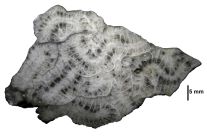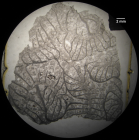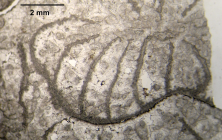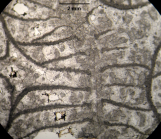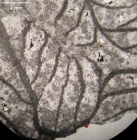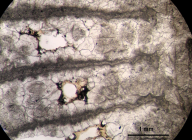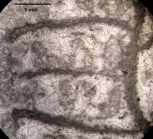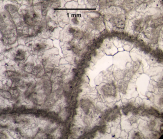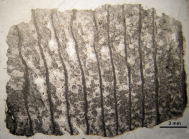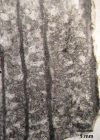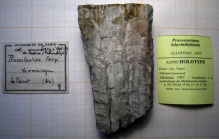Scleractinia taxon details
Pruvostastraea Alloiteau, 1957 †
1438027 (urn:lsid:marinespecies.org:taxname:1438027)
accepted
Genus
Pruvostastraea labyrinthiformis Alloiteau, 1957 † (type by original designation)
Tskhanarella Sikharulidze, 1979 † · unaccepted > junior subjective synonym
marine, fresh, terrestrial
fossil only
Alloiteau J. (1957). Contribution à la systématique des Madréporaires fossiles. <em>Centre National de la Recherche Scientifique, Paris.</em> pp 462. [details]
Description Massive meandroid colony made of tortuous series. The intracalicinal increase produces calicular centers not always...
Status Pruvostastraea has been attributed to the family of Amphiastraeidae by Alloiteau (1957) and to the subordinate sub-family...
Description Massive meandroid colony made of tortuous series. The intracalicinal increase produces calicular centers not always distinct, but always in a single row within the valley. Collines made of walls that end abruptly, turning and becoming septa that reach the centers of the valleys. Radial elements are compact, straight to strongly curved, free, but occasionally bifurcating, bicuneiform or with a uniform thickness, unequal (two size orders). Lateral faces covered of small abundant closely arranged granules. Inner edge claviform (auriculae) with a rather constant distance kept between the inner edge and the lamellar columella. Microstructure with a midseptal line and secondary trabecular axes diverging from the midseptal plan to produce lateral granules (4-5/mm). Endotheca made of vesicular dissepiments, columella lamellar and thin when present. Synapticulae absent. Septothecal wall. [details]
Status Pruvostastraea has been attributed to the family of Amphiastraeidae by Alloiteau (1957) and to the subordinate sub-family...
Status Pruvostastraea has been attributed to the family of Amphiastraeidae by Alloiteau (1957) and to the subordinate sub-family Pruvostastraeinae by Beauvais (1981). Subsequently Eliášová (1973) attributed Pruvostastraea to the sub-family Rhipidogyrinae (or family Rhipidogyridae Koby, 1905). This family assignment was then followed by Rosendahl 1985 and Turnsek. [details]
Hoeksema, B. W.; Cairns, S. (2025). World List of Scleractinia. Pruvostastraea Alloiteau, 1957 †. Accessed at: https://www.marinespecies.org/Scleractinia/aphia.php?p=taxdetails&id=1438027 on 2025-05-06
Date
action
by
original description
Alloiteau J. (1957). Contribution à la systématique des Madréporaires fossiles. <em>Centre National de la Recherche Scientifique, Paris.</em> pp 462. [details]
original description (of Tskhanarella Sikharulidze, 1979 †) Sikharulidze, G.Y. (1979). Albskie korally sela Ckhanari. <em>Trudy, Akademia Nauk Gruzinskoy SSR. Geologicheskiy Institut, Tbilisi, novaya seria, vyp.,.</em> 63: 5–49. [details]
basis of record Cairns, S.D., R. Baron-Szabo, A.F. Budd, B. Lathuilière, E. Roniewicz, J. Stolarski & K.G. Johnson. (2010). Corallosphere. , available online at http://www.corallosphere.org [details]
additional source Eliášová H. (1973). Sous-famille Rhipidogyrinae Koby, 1905 (Hexacorallia) des calcaires de de Stramberk (Tithonien, Tchecoslovaquie). <em>Časopis pro Mineralogii a Geologii.</em> 18(3): 267-287, pls. 1-14. [details]
original description (of Tskhanarella Sikharulidze, 1979 †) Sikharulidze, G.Y. (1979). Albskie korally sela Ckhanari. <em>Trudy, Akademia Nauk Gruzinskoy SSR. Geologicheskiy Institut, Tbilisi, novaya seria, vyp.,.</em> 63: 5–49. [details]
basis of record Cairns, S.D., R. Baron-Szabo, A.F. Budd, B. Lathuilière, E. Roniewicz, J. Stolarski & K.G. Johnson. (2010). Corallosphere. , available online at http://www.corallosphere.org [details]
additional source Eliášová H. (1973). Sous-famille Rhipidogyrinae Koby, 1905 (Hexacorallia) des calcaires de de Stramberk (Tithonien, Tchecoslovaquie). <em>Časopis pro Mineralogii a Geologii.</em> 18(3): 267-287, pls. 1-14. [details]
 Present
Present  Inaccurate
Inaccurate  Introduced: alien
Introduced: alien  Containing type locality
Containing type locality
From editor or global species database
Comparison The way in which the wall turns to a septum has no equivalent in other genera. [details]Description Massive meandroid colony made of tortuous series. The intracalicinal increase produces calicular centers not always distinct, but always in a single row within the valley. Collines made of walls that end abruptly, turning and becoming septa that reach the centers of the valleys. Radial elements are compact, straight to strongly curved, free, but occasionally bifurcating, bicuneiform or with a uniform thickness, unequal (two size orders). Lateral faces covered of small abundant closely arranged granules. Inner edge claviform (auriculae) with a rather constant distance kept between the inner edge and the lamellar columella. Microstructure with a midseptal line and secondary trabecular axes diverging from the midseptal plan to produce lateral granules (4-5/mm). Endotheca made of vesicular dissepiments, columella lamellar and thin when present. Synapticulae absent. Septothecal wall. [details]
Remark The genus is monospecific and known only in the Upper Jurassic (and possibly Berriasian) of Europe. [details]
Status Pruvostastraea has been attributed to the family of Amphiastraeidae by Alloiteau (1957) and to the subordinate sub-family Pruvostastraeinae by Beauvais (1981). Subsequently Eliášová (1973) attributed Pruvostastraea to the sub-family Rhipidogyrinae (or family Rhipidogyridae Koby, 1905). This family assignment was then followed by Rosendahl 1985 and Turnsek. [details]
